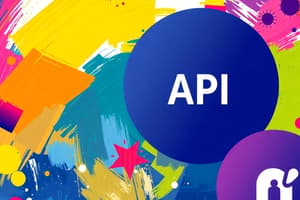Podcast
Questions and Answers
What is the purpose of Body Params in a request?
What is the purpose of Body Params in a request?
- To allow querying/filtering through a list of resources
- To influence the response by the server
- To contain all the data needed for the server to process the request (correct)
- To specify which resource the client would like to access
In a REST API, what does a POST method do?
In a REST API, what does a POST method do?
- Update an API resource
- Receive information about an API resource
- Delete an API resource
- Create an API resource (correct)
What type of parameter helps in pointing towards a specific resource in the URI path?
What type of parameter helps in pointing towards a specific resource in the URI path?
- Path Parameter (correct)
- Query Parameter
- Header
- Authentication token
Which HTTP Status Code indicates a problem with the client?
Which HTTP Status Code indicates a problem with the client?
What kind of information can be sent via Headers in a request?
What kind of information can be sent via Headers in a request?
What is the primary purpose of an API (Application Programming Interface)?
What is the primary purpose of an API (Application Programming Interface)?
What is the key difference between SOAP web services and RESTful web services?
What is the key difference between SOAP web services and RESTful web services?
What is the purpose of the URL (Uniform Resource Locator) in the context of a REST API?
What is the purpose of the URL (Uniform Resource Locator) in the context of a REST API?
Which HTTP method is typically used to create a new resource in a REST API?
Which HTTP method is typically used to create a new resource in a REST API?
What is the role of the HTTP protocol in a RESTful web service?
What is the role of the HTTP protocol in a RESTful web service?
Flashcards are hidden until you start studying
Study Notes
Introduction to REST API
- API (Application Programming Interface) is a set of functions, procedures, methods, or classes used by computer programs to request services from the OS, software libraries, or other service providers.
What is an API?
- API allows interactions between systems by following a set of standards and protocols to share features, information, and data.
- API acts as an interface between different applications.
What is REST and RESTful API?
- REST (Representational State Transfer) is an architecture style to develop web applications.
- REST uses HTTP protocol as a communication interface.
- RESTful API is a service that uses REST APIs to communicate.
Request Anatomy
- URL (Uniform Resource Locator) is the address to not just identify a resource but also to specify how to access it.
- URI (Uniform Resource Identifier) is used in the URL to specify which resource the client would like to access in a request.
- Every URL is an URI, but not all URIs are URLs.
- Body Params are the body of the request that contains all the data that the server needs to successfully process the request.
- Parameters are information that can be sent in a request by the client to influence the response by the server.
Parameters
- 2 types of parameters:
- Path Parameter: a variable in the URI path that helps in pointing towards a specific resource.
- Query Parameter: a variable in the URI path that helps querying/filtering through a list of resources.
Headers
- Headers allow sending extra information in a request, such as authentication tokens and content types.
REST API Methods
- GET: Receive information about an API resource.
- POST: Create an API resource.
- PUT: Update an API resource.
- DELETE: Delete an API resource.
HTTP Status Codes
- 2XX: Success
- 3XX: Redirection
- 4XX: Problem with the client
- 5XX: Problem with the server
Benefits of REST API
- Simple and standardized approach to communication.
- Scalable and stateless.
- High Performance.
Studying That Suits You
Use AI to generate personalized quizzes and flashcards to suit your learning preferences.




